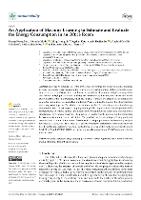Resumen
There are no exact criteria for the architecture of openings and windows in office buildings in order to optimize energy consumption. Due to the physical limitations of this renewable energy source and the lack of conscious control over its capabilities, the amount of light entering offices and the role of daylight as a source of energy are determined by how they are constructed. In this study, the standard room dimensions, which are suitable for three to five employees, are compared to computer simulations. DesignBuilder and EnergyPlus are utilized to simulate the office’s lighting and energy consumption. This study presents a new method for estimating conventional energy consumption based on gene expression programming (GEP). A gravitational search algorithm (GSA) is implemented in order to optimize the model results. Using input and output data collected from a simulation of conventional energy use, the physical law underlying the problem and the relationship between inputs and outputs are identified. This method has the advantages of being quick and accurate, with no simulation required. Based on effective input parameters and sensitivity analysis, four models are evaluated. These models are used to evaluate the performance of the trained network based on statistical indicators. Among all the GEP models tested in this study, the one with the lowest MAE (0.1812) and RMSE (0.09146) and the highest correlation coefficient (0.90825) is found to be the most accurate. © 2023 by the authors. Licensee MDPI, Basel, Switzerland.














